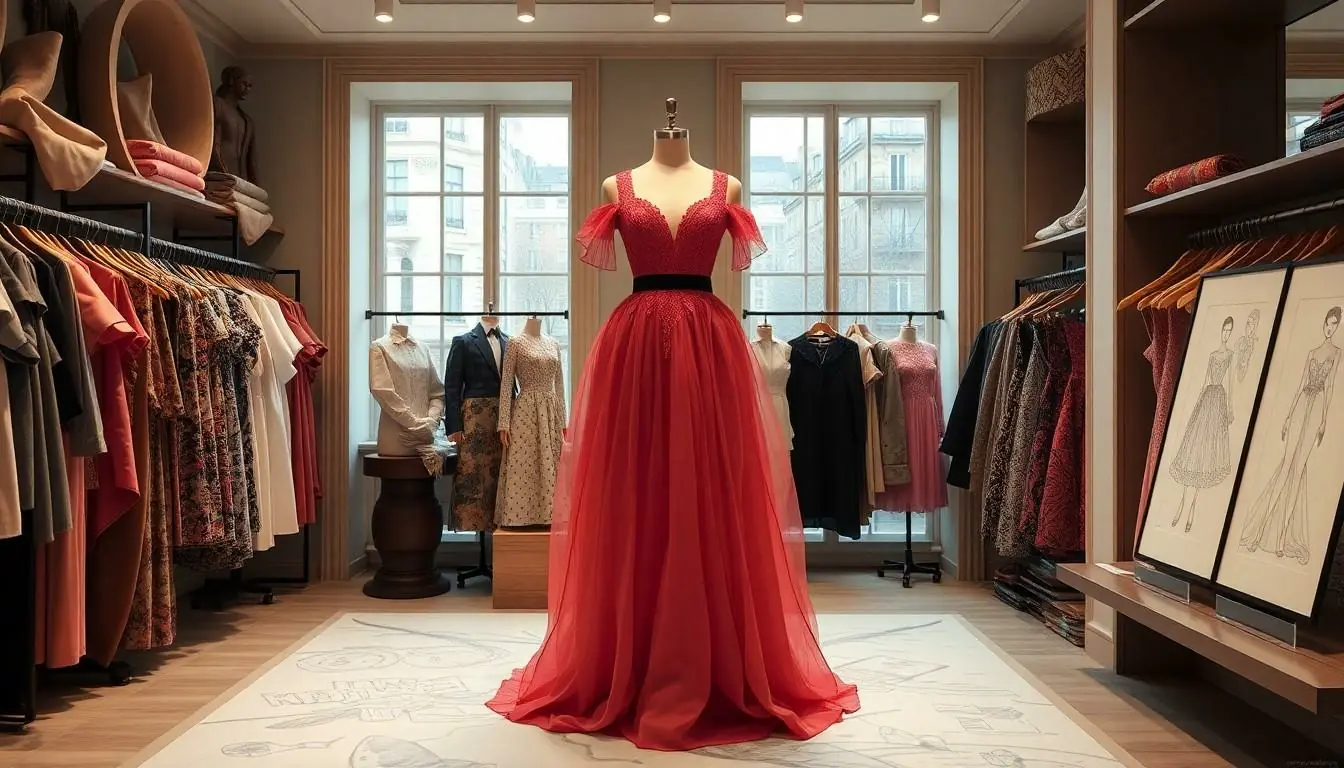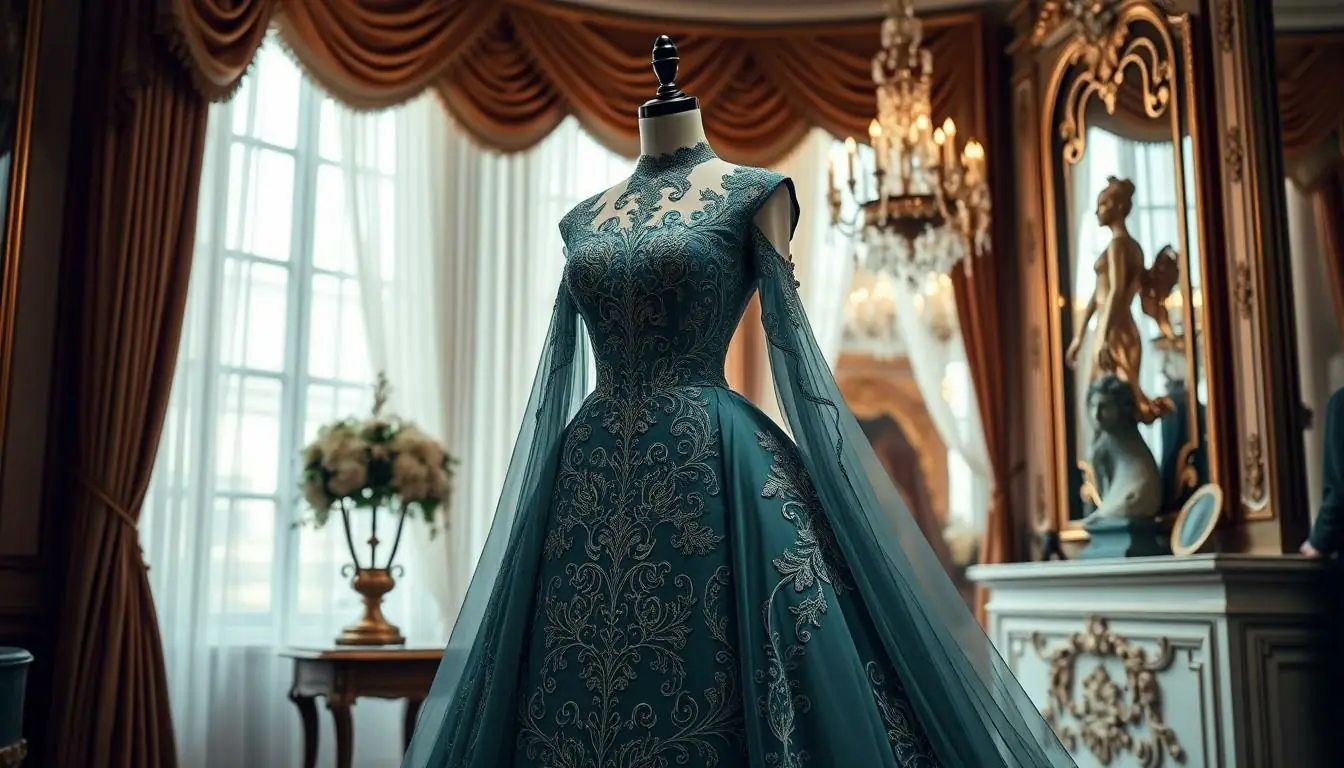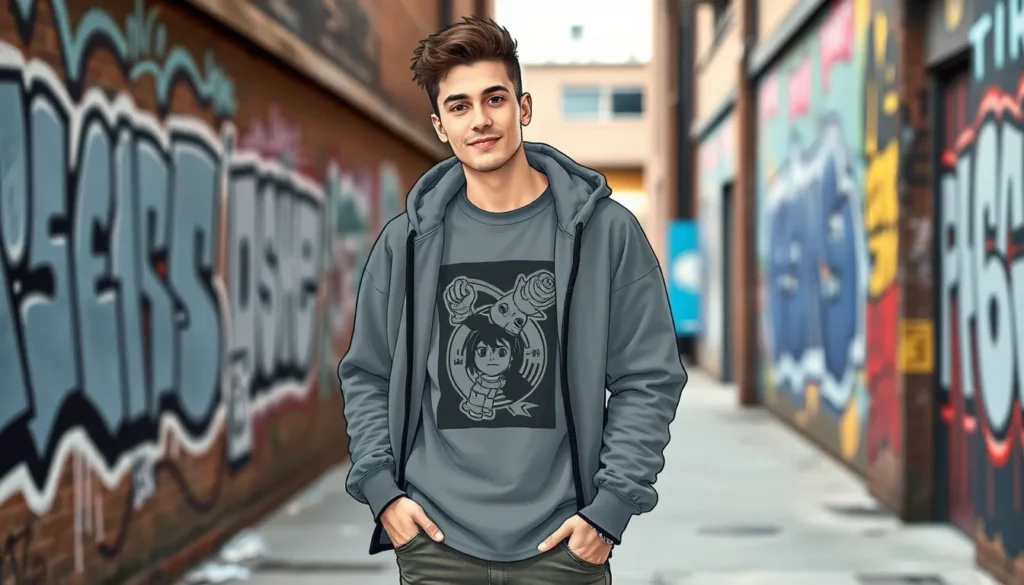In the glamorous world of fashion, haute couture houses reign supreme, crafting exquisite pieces that make mere mortals weak at the knees. Picture this: a dazzling gown that could make even a potato sack feel envious. These elite design ateliers aren’t just about fabric and thread; they’re the wizards of style, conjuring masterpieces that turn heads and drop jaws.
Table of Contents
ToggleOverview of Haute Couture Houses
Haute couture houses represent the pinnacle of fashion design, characterized by their unique, handcrafted creations. Each house showcases its distinct aesthetic through meticulous attention to detail and exquisite materials. Renowned brands like Chanel, Dior, and Givenchy set industry standards, producing garments that often serve as art pieces.
Traditionally, haute couture follows strict regulations established by the Chambre Syndicale de la Haute Couture in Paris. Each collection includes a minimum of 50 ensemble pieces that epitomize creativity and technical skill. Most designs undergo hundreds of hours of labor, resulting in garments that cost thousands or even millions.
Fashion houses often reveal collections during Paris Fashion Week, captivating audiences with innovative techniques and luxurious fabrics. The designs reflect cultural influences, drawing inspiration from history, art, and nature. Couture houses frequently collaborate with artisans and specialists, ensuring every piece achieves perfection.
Some houses also embrace sustainability, sourcing eco-friendly materials and employing ethical production methods. This trend attracts a new generation of conscious consumers who appreciate the craftsmanship behind haute couture. In contrast, others remain committed to tradition, continuing time-honored techniques and styles.
Clients of haute couture houses seek exclusivity and personalization, with many garments made to measure. Such customization enhances the shopping experience, offering customers unique pieces tailored to their specifications. Celebrated clients often wear these creations to significant events, further solidifying the allure of haute couture.
Prominent fashion houses influence mainstream trends, setting styles that trickle down to ready-to-wear collections. Through their exquisite designs and cultural significance, haute couture houses maintain a vital role in the fashion industry, inspiring admiration and aspiration across the globe.
Historical Background

Haute couture houses have a rich history shaped by innovation and artistry. These iconic establishments revolutionized fashion through their unique creations.
Origins of Haute Couture
The origins of haute couture trace back to the mid-19th century. Charles Frederick Worth, known as the father of haute couture, established the first fashion house in Paris around 1858. His designs attracted aristocratic clients, emphasizing customization and luxurious fabrics. Worth’s fashion shows, featuring live models, marked a significant departure from previous presentation methods. These early creations set a standard for opulence and artistry, paving the way for future fashion houses.
Evolution Over the Decades
Fashion underwent substantial transformation through the decades, influenced by societal changes and technological advancements. In the 1920s, designers like Coco Chanel and Elsa Schiaparelli redefined femininity through simplified silhouettes. The post-World War II era saw Christian Dior introduce the “New Look,” celebrating a return to grandeur with hourglass silhouettes. The 1970s and 1980s brought experimentation and the rise of ready-to-wear, although haute couture maintained its allure. Recent decades reflect a fusion of traditional techniques with contemporary sustainability practices, showcasing a unique blend of heritage and modernity in haute couture creations.
Notable Haute Couture Houses
Renowned for their artistry, haute couture houses shape fashion history with their intricate designs and skilled craftsmanship. Several houses stand out for their creative innovation.
Chanel
Chanel, founded by Gabrielle Chanel in 1910, revolutionized women’s fashion. Its signature elements include the Chanel suit and the iconic little black dress. These designs symbolize elegance and modern femininity. The house focuses on timeless elegance, incorporating luxurious fabrics and impeccable tailoring. Seasonal collections consistently reflect Chanel’s heritage while embracing contemporary trends. Natalie Portman and Kristen Stewart showcase Chanel’s striking pieces on red carpets, exemplifying haute couture’s allure.
Dior
Dior emerged as a dominant force in fashion after World War II. Christian Dior introduced the “New Look,” celebrated for its hourglass silhouette and luxurious materials. This style redefined femininity and remains influential. Dior’s collections emphasize intricate embroidery and exceptional craftsmanship, ensuring every piece embodies elegance. High-profile clients, like Jennifer Lawrence and Charlize Theron, often wear Dior creations, further solidifying the house’s prestigious status in the fashion world.
Givenchy
Givenchy, founded by Hubert de Givenchy in 1952, blends sophistication and modernity. The house gained fame for creating elegant and innovative designs, including the iconic dresses worn by Audrey Hepburn. Signature elements feature clean lines and exquisite tailoring. Collections frequently showcase exquisite fabrics and artisanal details, underscoring Givenchy’s commitment to haute couture excellence. Celebrities such as Meghan Markle and Rihanna frequently don Givenchy, highlighting its influence on contemporary fashion.
Valentino
Valentino, established in 1960, signifies luxury and romanticism in fashion. Known for its bold red gowns and intricate beadwork, the house captures attention on runways and red carpets. Creative director Pierpaolo Piccioli emphasizes inclusivity and modern aesthetics in collections. Each piece showcases exceptional craftsmanship and artistic flair. Stars like Lady Gaga and Anne Hathaway often choose Valentino, reinforcing its status as a leader in haute couture.
The Creative Process in Haute Couture
Haute couture embodies a unique creative journey, meticulously crafted through exclusive techniques.
Design and Tailoring Techniques
Innovative design processes characterize haute couture, attracting skilled artisans who excel in precision. Each garment begins with a vision that evolves through sketches and prototypes. Tailoring techniques employ time-honored methods that include draping and pattern-making, ensuring a perfect fit. Exclusive fittings allow designers to consult clients, allowing for personalized adjustments. Exceptional craftsmanship emerges through labor-intensive practices, requiring hundreds of hours for a single piece. Masters of the trade tirelessly hone their skills to create garments that redefine elegance in fashion.
Materials and Fabrics Used
High-quality materials enhance the allure of haute couture, with luxurious fabrics chosen for their unique properties. Silks, satins, and organzas often take center stage, providing a foundation for opulent designs. Designers incorporate intricate embellishments like sequins, beads, and lace to elevate the artistry. Exclusive materials sourced from across the globe add a distinctive touch, reflecting the designer’s vision and creativity. Limited availability of these fabrics enhances their desirability, reinforcing the exclusivity of haute couture pieces. Sustainability considerations increasingly influence material selection, appealing to a new generation of conscious consumers.
The Impact of Haute Couture on Fashion
Haute couture significantly shapes the fashion landscape, influencing culture, economic trends, and public perception.
Cultural Influence
Cultural narratives often revolve around haute couture, showcasing artistic expression and identity. Designers convey messages through their creations, influencing art, music, and film. Iconic looks from Chanel and Dior frequently appear in popular culture, shaping perceptions of beauty and elegance. Additionally, cultural diversity enriches haute couture’s narrative, as many houses embrace global inspirations, enhancing creativity. Collectively, these influences establish haute couture as more than fashion; it embodies a cultural phenomenon, sparking dialogues about gender, body image, and sustainability.
Economic Significance
The economic impact of haute couture extends beyond luxury fashion houses. This sector generates thousands of jobs, from skilled artisans to marketers, sustaining local economies. Significant revenue stems from wealthy clientele, making bespoke pieces a lucrative venture for designers. Haute couture also drives tourism, particularly in fashion capitals like Paris during Fashion Week; the influx of international visitors bolsters local businesses. Furthermore, haute couture trends often filter down to ready-to-wear lines, influencing mass-market production and sales, merging exclusivity with widespread accessibility.
Conclusion
Haute couture houses represent the pinnacle of fashion artistry and craftsmanship. These elite design studios not only create stunning garments but also serve as cultural icons that influence trends and societal narratives. Their commitment to quality and innovation continues to inspire admiration and aspiration across the globe.
As haute couture evolves, it blends tradition with modern sustainability practices, appealing to a new generation of fashion enthusiasts. The unique blend of heritage and contemporary design ensures that these houses remain at the forefront of the fashion industry. Ultimately, haute couture is more than just clothing; it’s a celebration of creativity, exclusivity, and the enduring power of fashion.








